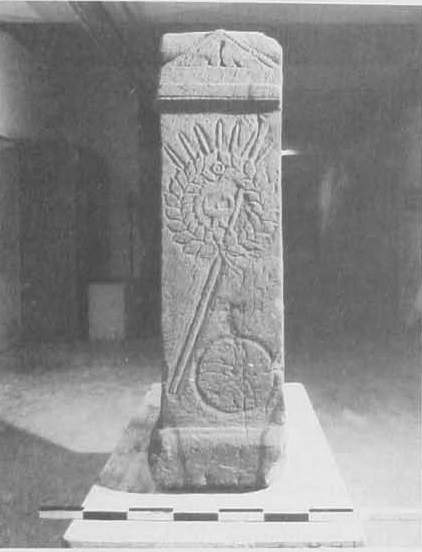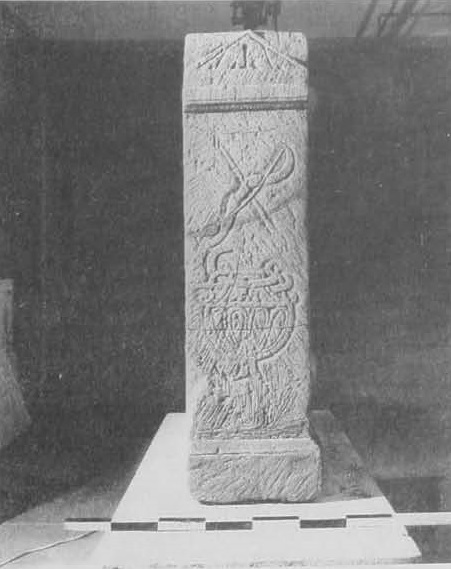
CIMRM Supplement - Altar. Burginatium (Alt-Kalkar), Germany.
A stray altar found in 1983 near the Dutch border. It is now in the Rheinisches Landesmuseum, Bonn, inv. nr. F 1/84.
... a modest monument from Germania Inferior found some fifteen years ago, but hitherto almost completely neglected in general discussion of the mysteries. What survives is the base for a bronze statue (aes) in the form of a votive altar, in the red sandstone of the North Eifel, a stray find ploughed up in 1983 near the site of the auxiliary castellum at Burginatium (Alt- Kalkar) near Kalkar in the Landkreis Kleve, Nordrhein-Westfalen, in the Rhine valley just by the Dutch border. [5] It thus enjoys the distinction of being the most northerly in situ Mithraic find on the Continent.
The face is occupied by a dedicatory inscription of some interest, since its reference to Mithras commanding a specific votive helps to resolve a minor puzzle in the Mithraic epigraphy of the area:
D(eo) Invicto) I(mperatori) Ulp(ius) • (Am(---) • (p(ater) s(acrorum) aes • ex iussu su • ip•sius
Letter heights: 1.1: 7.5 cm; remainder: 6 cm. ....
... the significant feature of the altar is its lateral faces (the back was left rough).
The right hand side shows (fig. 1), beneath a moulding, a schematic victory crown in laurel, with fillet and central disk, surmounted by seven rays. Within the crown is a lighted lamp with a high base and vertical handle. Supporting these is a staff with a slightly thickened top perhaps suggesting a whip; beside it, at the bottom, is a globe with a schematic representation of the celestial equator crossing the ecliptic. This symbolism evidently refers, in a very general manner, to the place of Helios-Sol in the cult.
On the left side (fig. 2), we find a bow in the resting position but armed with an arrow, and below it a krater, apparently thought of as made of metal, with a high base similar to that of the lamp on the other side, and elaborately decorated with repoussé whorls, encircled by a snake, whose crested head is about to enter its mouth. This face evidently links Mithras' water miracle with the krater, which occurs on a number of representations of the feast-scene, and thus refers to Mithras' saving acts. The two lateral faces thus contrast, while uniting, Helios- Sol and Mithras.
[5] H. 116, W. 76, D. 33 cm, now in the Rheinisches Landesmuseum, Bonn, inv. nr. F 1/84; further details in H. G.Horn, 'Eine Mithras-weihung vom Niederrhein,' Ausgrabungen im Rheinland 1983/84 Rheinisches Landesmuseum, Bonn: Kunst and Altertum am Rhein nr. 122 (Cologne and Bonn, 1985), 151-55 = id., Das Rheinische Landesmuseum Bonn: Berichte aus der Arbeit des Museums 4 (1985), 50-1. The fuller publication by Christoph Rüger referred to there seems never to have appeared. I am grateful to Dr. G. Bauchhens for assistance in obtaining photographs.
Bibliography
- R. L. Gordon, "Viewing mithraic art : the altar from Burginatium (Kalkar), Germania Inferior", Antigüedad: Religiones y Sociedades 1 (1998), 227-258. Online in various places, e.g. here.
| Tweet |

